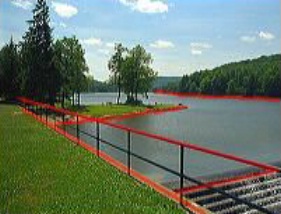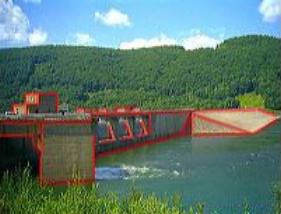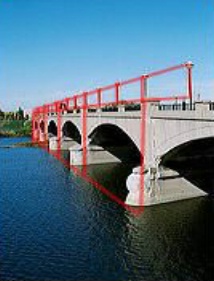|
|
|
|

Lonely Picnic Ground
Not all of the lines in these are highlighted. You can obviously see more.
John A. Lind
|
|
|
|

Kinzua Dam I
More lines and shapes
John A. Lind
|
|
|
|

White River Park Pedestrian Bridge
Yet more lines and shapes; some are "hidden" in that the eye and brain "connects the dots" to complete them!
John A. Lind
|
|
|
|
Hi Maria,
Sounds like you are getting some very classical instruction about image composition. This is a Good Thing; stick with it!"Line" and "Shape" are referred to as "formal elements" in the visual fine arts, whether they are paintings, drawings or photographs. A third one, which your instructor may eventually get to is "Color." The concepts of Line and Shape as elements of "Form" (why they are called "Formal Elements") dates to Aristotle's "Physics" written in the 4th Century B.C., as one of his four Aitiai (translates from Greek as "causes"). It is an abstraction of what an object looks like reduced to its basic form, without regard for the materials it is made from. A silhouette is a classic example of "Form." What creates this "Form?" Lines, and combinations of lines are used to create fundamental Shapes (circles, triangles, rectangles, etc.), and fundamental shapes are combined to create complex shapes. Your instructor is trying to get you to take a scene and break it down into lines, and how the lines create fundamental (simple) shapes, and how the simple shapes are combined to create complex shapes. It is by abstracting a scene into these elements (lines and shapes), and working with a mental vision of them, that you can very deliberately compose an image that has visual appeal to its viewers. This exercise is not an end in itself; training yourself to do this is one of the first building blocks of studying composition. In the beginning, you have to consciously do this. As you gain experience, you will find yourself doing it automagically, without really thinking about it. What creates visible lines in a photograph? They are a sharp boundary between light and dark, or even two contrasting colors. The greater the contrast between the two sides of the boundary, the more prominent the line. You can use a basket of apples for lines and shapes, but I would recommend that you emphasize the visual contrast between the objects (basket, apples, etc.). I might pick an object with simpler shape than an apple, but it can still work. Put a small basket with a few apples on a table near a window during the middle of a bright day, and turn off all the lights inside the room. If you look at it with the window behind you, in the same direction as the light is shining on it this is called "front lighting" (don't block the light too much). There isn't that much contrast between individual apples or the pieces of the basket. Now move to the side and look at it. What you see now is called "side lighting." The contrast is much greater because the shadows formed by the objects that you see now are much deeper and the contrast greater. If you look at it from behind with the basket between you and the window (and the room is dark enough with the window bright enough) you will see its outline sihlouetted against the window. This is called "back lighting." Look for a lighting angle that makes the lines, which combine to create shapes, most prominent (probably the side). Break the complex shapes you see down into simpler shapes and lines (including curved lines). Don't worry about "texture," which is how rough or smooth a surface appears. It is the boundary lines between objects you are looking for. To help you out, I've uploaded several thumbnail images done for one of my web pages that has lines drawn on it showing the basic lines in the photograph. Look at the shapes they form, and then apply it to what you do. Hope this helps you out with some ideas for your assignment. -- John
September 27, 2000
|